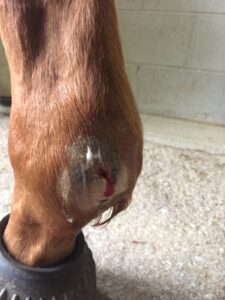Horses’ heightened flight response combined with their long, spindly legs create a perfect storm for abrasions, contusions, punctures, and lacerations. And lack of veterinary involvement when managing wounds, particularly on the lower limbs, can spin those storms into hurricanes.
Richard Birnie, a final-year veterinary student who has conducted research on equine wound treatment at the University of Nottingham, in the U.K., says multiple researchers have reported that traumatic wounds in horses are the second-most-common emergency veterinarians see, with colic being the first.
These traumatic wounds vary remarkably in their presentation, and simple visual inspection doesn’t always reveal the extent of the injury. Biodyl 50ml
“Inappropriate management of a wound can delay the institution of appropriate therapies, negatively affect outcome, and dramatically increase the cost of treatment,” Birnie says. “The prognosis for return to function can also decrease, while the time taken to return to work can be extended due to the development of complications.”
Richard Birnie
MRes
While a veterinary student at the University of Nottingham, in the U.K., Richard Birnie performed research on horse owner attitudes about equine wound management. He presented his team’s findings during the British Equine Veterinary Association’s 2020 Clinical Research Week.
Richard Birnie
MRes
While a veterinary student at the University of Nottingham, in the U.K., Richard Birnie performed research on horse owner attitudes about equine wound management. He presented his team’s findings during the British Equine Veterinary Association’s 2020 Clinical Research Week.
How To Handle Equine Wounds Isn’t Always Clear-Cut
If you’re like many horse owners, your barn has a cupboard full of first-aid supplies, salves, ointments, sprays, and powders. Together with self-adhesive wrap, Dr. Google, and advice from your horse-owning friends, you might feel appropriately armed to deal with an array of wounds, but Birnie’s research results suggest otherwise.
While horse owners’ intentions are good, many don’t call their veterinarian right away, potentially creating more problems than they’re solving. To assess owners’ understanding of equine wounds, Birnie and University of Nottingham colleagues, including Professor Sarah Freeman, BVetMed, PhD, Cert. VA, Cert. VR, Cert. ES, Dipl. ECVS, FHEA, MRCVS, surveyed more than 1,000 horse owners about how they would manage seven hypothetical wound scenarios (e.g., puncture wounds, kick injuries, degloving injuries).
“Owners stated that the most important factors influencing their decision to seek veterinary advice were the depth and location of the wound, as well as the amount of bleeding,” Birnie says.
Wounds over joints can threaten synovial structures that are at risk for infection and require immediate veterinary attention.
However, when presented with a hypothetical wound situation, survey participants didn’t consistently put this methodology into practice. For example, owners were unskilled at recognizing the severity of deep puncture wounds over synovial structures, such as a joint or tendon sheath. According to survey results, less than 25% of surveyed horse owners thought these small punctures were a high priority, and 34% said they did not think a small puncture required any veterinary treatment.
“Despite appearing small and innocuous at skin level, if these small wounds extend deeper and involve synovial structures, it can be potentially catastrophic for the horse’s overall prognosis,” explains Birnie.
Besides the inability to recognize the severity of certain wounds, Birnie et al. found more than half the survey respondents chose to apply some form of contraindicated first-aid, relating specifically to wound cleaning, medicating, and bandaging.
Birnie’s survey results show that some owners used overly concentrated and, therefore, cytotoxic (toxic to cells) chlorhexidine solutions to clean wounds, which can impair and slow healing. They also commonly applied silver sulfadiazine to wounds; however, some silver products can also be cytotoxic and might not be appropriate for all wounds.
Overall, this work highlights the importance of veterinarian involvement in equine wound management. Apaan powder


